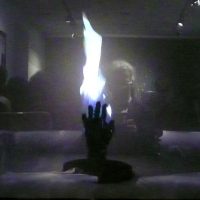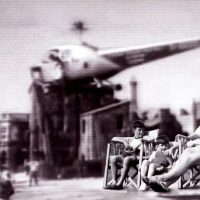Using very contrasting media, Horitz attempts to find new forms of language to describe the investigation into questions of identity and the truth of memory.
Hybrid Memories exhibited in the Somorja synagogue aimed to suggest the history of the space and the local Jewish community. Rather than using “real” documentary photos, Horitz replaced “a family” with her own. All families, Horitz suggests, comprise a hybrid quality or element, a mixture of nations, religions and stories – some visible or hidden, some fact or fiction.
How we remember and interpret stories and memories continues to change. Each image consists of a merging of layers of time. These layers enhance each other, the figure projected in the archive image is imitated and transferred into a new spectacle. The images encourage a filmic reading, a narrative interpretation, in which a multi-layered explanation is possible, where the facts of private histories come together with the imaginary, resulting in continually changing interpretations.
The Debris of War is a series of collages interweaving film stills with characters from Horitz’s family archive. By combining scenes of a bombed London landscape from Passport to Pimlico with images of her own family, Horitz creates new narratives which reflect a different level of consciousness.
The Genogram Experiment, is a hand blown glass sculptural installation. It takes the investigation of one’s past and identity to another level of interpretation. The Genogram Experiment, is used here more abstractly than the original analytical form, it enables a mapping of generations through a coded language, suggesting patterns of behaviour within families, an alternative investigation to the “role playing” of the Hybrid Memories series.
Anna Gács


